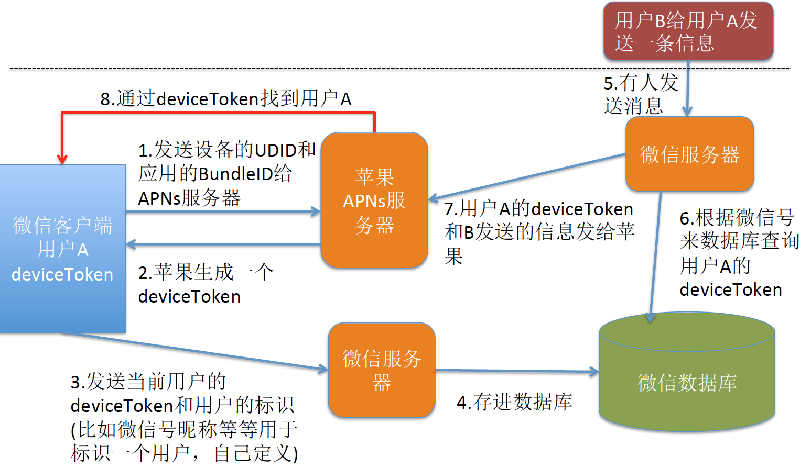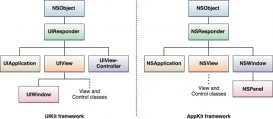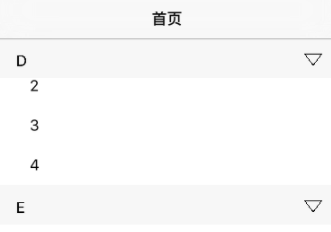一、简介
分为本地推送和远程推送2种。可以在应用没有打开甚至手机锁屏情况下给用户以提示。它们都需要注册,注册后系统会弹出提示框(如下图)提示用户是否同意,如果同意则正常使用;如果用户不同意则下次打开程序也不会弹出该提示框,需要用户到设置里面设置。一共有三种提示类型:
uiusernotificationtypebadge:应用图标右上角的信息提示
uiusernotificationtypesound:播放提示音
uiusernotificationtypealert:提示框

二、本地推送
1 注册与处理
代码如下:
|
1
2
3
4
5
6
7
8
9
10
11
12
13
14
15
16
|
/// 一般在在启动时注册通知,程序被杀死,点击通知后调用此程序- (bool)application:(uiapplication *)application didfinishlaunchingwithoptions:(nsdictionary *)launchoptions { if ([[uidevice currentdevice].systemversion floatvalue] >= 8.0) { // ios8 uiusernotificationsettings *setting = [uiusernotificationsettings settingsfortypes:uiusernotificationtypebadge | uiusernotificationtypealert | uiusernotificationtypesound categories:nil]; [application registerusernotificationsettings:setting]; } if (launchoptions[uiapplicationlaunchoptionslocalnotificationkey]) { // 这里添加处理代码 } return yes;}/// 程序没有被杀死(处于前台或后台),点击通知后会调用此程序- (void)application:(uiapplication *)application didreceivelocalnotification:(uilocalnotification *)notification { // 这里添加处理代码} |
可以看到,处理代码有两个方法,一个是
- (void)application:(uiapplication *)application didreceivelocalnotification:(uilocalnotification *)notification;
另一个是
- (bool)application:(uiapplication *)application didfinishlaunchingwithoptions:(nsdictionary *)launchoptions;
如果程序没有被杀死,即处于前台或者后台,那么调用前者;如果程序被杀死,则调用后者。
2 发送通知
代码如下
|
1
2
3
4
5
6
7
8
9
10
11
12
13
14
15
16
17
18
19
20
21
22
23
24
25
26
27
28
29
|
- (ibaction)addlocalnotification { // 1.创建一个本地通知 uilocalnotification *localnote = [[uilocalnotification alloc] init]; // 1.1.设置通知发出的时间 localnote.firedate = [nsdate datewithtimeintervalsincenow:5]; // 1.2.设置通知内容 localnote.alertbody = @"这是一个推送这是一个推送"; // 1.3.设置锁屏时,字体下方显示的一个文字 localnote.alertaction = @"赶紧!!!!!"; localnote.hasaction = yes; // 1.4.设置启动图片(通过通知打开的) localnote.alertlaunchimage = @"../documents/img_0024.jpg"; // 1.5.设置通过到来的声音 localnote.soundname = uilocalnotificationdefaultsoundname; // 1.6.设置应用图标左上角显示的数字 localnote.applicationiconbadgenumber = 999; // 1.7.设置一些额外的信息 localnote.userinfo = @{@"qq" : @"704711253", @"msg" : @"success"}; // 2.执行通知 [[uiapplication sharedapplication] schedulelocalnotification:localnote];} |
效果如下:

3 取消通知
// 取消所有本地通知
[application cancelalllocalnotifications];
三、远程推送
与android上我们自己实现的推送服务不一样,apple对设备的控制非常严格,消息推送的流程必须要经过apns(apple push notification service).
一般情况下如果一个程序退到后台就不能运行代码(audio、voip等等可以在后台运行),或者程序退出后,那么它就和对应应用的后台服务器断开了链接,就收不到服务器发送的信息了,但是每台设备只要联网就会和苹果的apns服务器建立一个长连接(persistent ip connection),这样只要通过苹果的apns服务器,我们自己的服务器就可以间接的和设备保持连接了,示意图如下:

使用步骤:
1 勾选backgroud modes -> remote notifications,主要是ios7之后,苹果支持后台运行,如果这里打开后,当接收到远程推送后,程序在后台也可以做一些处理,如下图所示:

2 远程推送的注册与本地推送不同,ios8.0前后也不同,代码见下面。
另外,在第一次使用推送时,可能会有这样的疑问:didfinishlaunchingwithoptions会在每次打开程序时被调用,那是不是每次都会调用注册函数,每次都会弹窗询问用户"是否允许推送通知"?其实这个窗口只会在第一次打开程序时弹出一次,无论用户允许或不允许苹果会记住用户的选择,注册函数调用多次对用户也没什么影响
|
1
2
3
4
5
6
7
8
9
10
11
12
13
14
15
|
- (bool)application:(uiapplication *)application didfinishlaunchingwithoptions:(nsdictionary *)launchoptions { // ios8之后和之前应区别对待 if ([[uidevice currentdevice].systemversion floatvalue] >= 8.0) { uiusernotificationsettings *settings = [uiusernotificationsettings settingsfortypes:uiusernotificationtypebadge | uiusernotificationtypealert | uiusernotificationtypesound categories:nil]; [[uiapplication sharedapplication] registerusernotificationsettings:settings]; } else { [application registerforremotenotificationtypes:uiremotenotificationtypealert | uiremotenotificationtypebadge | uiusernotificationtypesound]; } return yes;}/// 这个函数存在的意义在于:当用户在设置中关闭了通知时,程序启动时会调用此函数,我们可以获取用户的设置- (void)application:(uiapplication *)application didregisterusernotificationsettings:(uiusernotificationsettings *)notificationsettings { [application registerforremotenotifications];} |
3 如果注册失败,比如没有证书等等,会调用:
|
1
2
3
4
|
/// 注册失败调用- (void)application:(uiapplication *)application didfailtoregisterforremotenotificationswitherror:(nserror *)error { nslog(@"远程通知注册失败:%@",error);} |
4 获取devicetoken
如果用户同意,苹果会根据应用的 bundleid 和 手机udid 生成 devicetoken,然后调用 application 的 didregister 方法返回 devicetoken,程序应该把 devicetoken 发给应用的服务器,服务器有义务将其存储(如果允许多点登录,可能存多个 devicetoken)。devicetoken也是会变的: ”if the user restores backup data to a new device or computer, or reinstalls the operating system, the device token changes“,因此应每次都发给服务器(provider)
|
1
2
3
4
|
/// 用户同意后,会调用此程序,获取系统的devicetoken,应把devicetoken传给服务器保存,此函数会在程序每次启动时调用(前提是用户允许通知)- (void)application:(uiapplication *)application didregisterforremotenotificationswithdevicetoken:(nsdata *)devicetoken { nslog(@"devicetoken = %@",devicetoken);} |
5 用户点击了通知
默认会打开程序。处理代码有三个函数,分ios7之前之后和程序是否处于后台
5.1 ios7及其之之后
此函数无论是程序被杀死还是处于后台,只要用户点击了通知,都会被调用,因此如果是ios7,则不必在didfinishlaunchingwithoptions中做处理,只在下面函数做处理即可,此时应避免在didfinishlaunchingwithoptions函数中也做重复处理。
|
1
2
3
|
- (void)application:(uiapplication *)application didreceiveremotenotification:(nsdictionary *)userinfo fetchcompletionhandler:(void (^)(uibackgroundfetchresult))completionhandler { // userinfo} |
注:当在第一步打开后台运行后,用户不点击通知,也可以执行:
|
1
|
- (void)application:(uiapplication*)application didreceiveremotenotification:(nsdictionary*)userinfo fetchcompletionhandler:(void(^)(uibackgroundfetchresult))completionhandler |
5.2 ios7之前
当用户点击通知后,如果程序被杀死则会调用下面第一个函数,如果程序处于后台会调用下面第二个函数,因此下面两个函数应搭配使用
|
1
2
3
4
5
6
7
8
9
10
11
12
|
- (bool)application:(uiapplication *)application didfinishlaunchingwithoptions:(nsdictionary *)launchoptions { // 获取远程推送消息 nsdictionary *userinfo = launchoptions[uiapplicationlaunchoptionsremotenotificationkey]; if (userinfo) { // 有推送的消息,处理推送的消息 } return yes;}/// ios3之后才有,只有在程序处于后台时,用户点击了通知后才会被调用,应搭配didfinishlaunchingwithoptions使用- (void)application:(uiapplication *)application didreceiveremotenotification:(nsdictionary *)userinfo { // userinfo} |
在实际编程时,如果想兼容ios7以前,三个函数可同时使用,都列出来,系统会自动选择合适的调用。
6 总结下函数的调用:
首次安装后启动:
didregisterforremotenotificationswithdevicetoken 被调用
系统询问用户是否同意接收 notifications
不管用户选择同意或拒绝,didregisterusernotificationsettings 被调用
应用非首次启动时:
如果 notifications 处于拒绝状态:didregisterusernotificationsettings 被调用
如果 notifications 处于允许状态
didregisterforremotenotificationswithdevicetoken 被调用
didregisterusernotificationsettings 被调用
应用运行过程中用户修改 notifications 设置:
从拒绝变为允许:didregisterforremotenotificationswithdevicetoken 被调用
从允许变为拒绝:什么也不发生
7 服务端推送的格式
|
1
2
3
4
5
6
7
8
9
|
{ "aps" : { // 必须有 "alert" : "string", "body" : "string", "badge" : number, "sound" : "string" }, "notiid" : 20150821, // 自定义key值} |
8 推送的大小限制
远程通知负载的大小根据服务器使用的api不同而不同。当使用http/2 provider api时,负载最大为4kb;当使用legacy binary interface时,负载最大为2kb。当负载大小超过规定的负载大小时,apns会拒绝发送此通知。
9 整体如下图所示(以微信推送为例):

10 最后,还需要申请证书,这里不再详述-_-
以上就是本文的全部内容,希望对大家的学习有所帮助,也希望大家多多支持服务器之家。
















